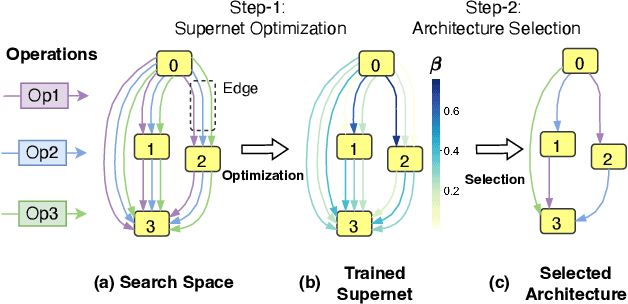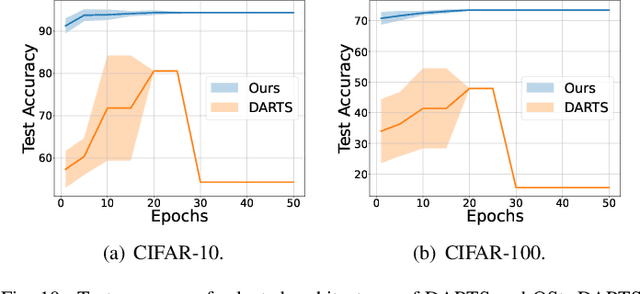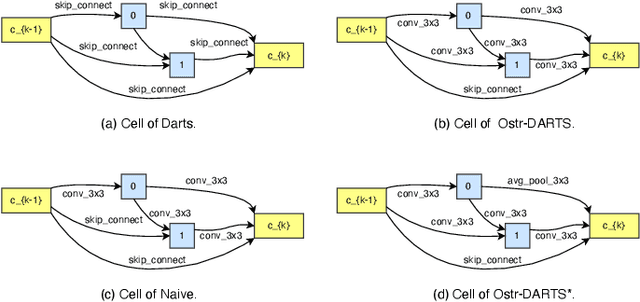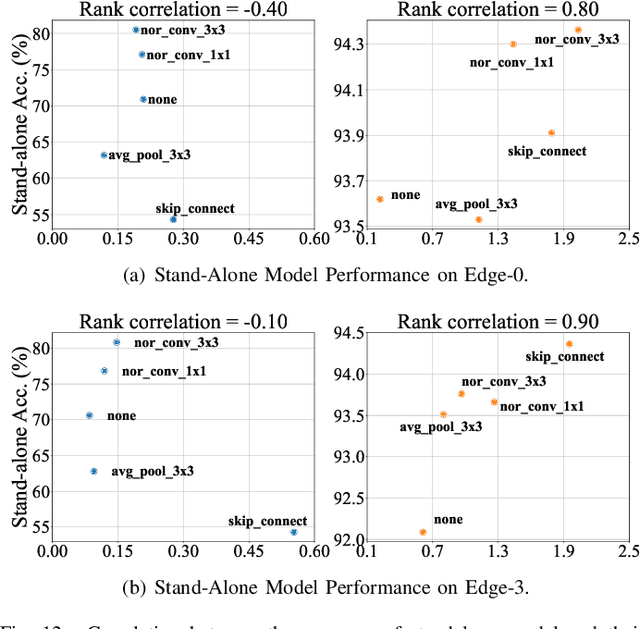Yizeng Han
FPSAttention: Training-Aware FP8 and Sparsity Co-Design for Fast Video Diffusion
Jun 06, 2025Abstract:Diffusion generative models have become the standard for producing high-quality, coherent video content, yet their slow inference speeds and high computational demands hinder practical deployment. Although both quantization and sparsity can independently accelerate inference while maintaining generation quality, naively combining these techniques in existing training-free approaches leads to significant performance degradation due to the lack of joint optimization. We introduce FPSAttention, a novel training-aware co-design of FP8 quantization and sparsity for video generation, with a focus on the 3D bi-directional attention mechanism. Our approach features three key innovations: 1) A unified 3D tile-wise granularity that simultaneously supports both quantization and sparsity; 2) A denoising step-aware strategy that adapts to the noise schedule, addressing the strong correlation between quantization/sparsity errors and denoising steps; 3) A native, hardware-friendly kernel that leverages FlashAttention and is implemented with optimized Hopper architecture features for highly efficient execution. Trained on Wan2.1's 1.3B and 14B models and evaluated on the VBench benchmark, FPSAttention achieves a 7.09x kernel speedup for attention operations and a 4.96x end-to-end speedup for video generation compared to the BF16 baseline at 720p resolution-without sacrificing generation quality.
DyDiT++: Dynamic Diffusion Transformers for Efficient Visual Generation
Apr 09, 2025Abstract:Diffusion Transformer (DiT), an emerging diffusion model for visual generation, has demonstrated superior performance but suffers from substantial computational costs. Our investigations reveal that these costs primarily stem from the \emph{static} inference paradigm, which inevitably introduces redundant computation in certain \emph{diffusion timesteps} and \emph{spatial regions}. To overcome this inefficiency, we propose \textbf{Dy}namic \textbf{Di}ffusion \textbf{T}ransformer (DyDiT), an architecture that \emph{dynamically} adjusts its computation along both \emph{timestep} and \emph{spatial} dimensions. Specifically, we introduce a \emph{Timestep-wise Dynamic Width} (TDW) approach that adapts model width conditioned on the generation timesteps. In addition, we design a \emph{Spatial-wise Dynamic Token} (SDT) strategy to avoid redundant computation at unnecessary spatial locations. TDW and SDT can be seamlessly integrated into DiT and significantly accelerates the generation process. Building on these designs, we further enhance DyDiT in three key aspects. First, DyDiT is integrated seamlessly with flow matching-based generation, enhancing its versatility. Furthermore, we enhance DyDiT to tackle more complex visual generation tasks, including video generation and text-to-image generation, thereby broadening its real-world applications. Finally, to address the high cost of full fine-tuning and democratize technology access, we investigate the feasibility of training DyDiT in a parameter-efficient manner and introduce timestep-based dynamic LoRA (TD-LoRA). Extensive experiments on diverse visual generation models, including DiT, SiT, Latte, and FLUX, demonstrate the effectiveness of DyDiT.
Bridging the Divide: Reconsidering Softmax and Linear Attention
Dec 09, 2024



Abstract:Widely adopted in modern Vision Transformer designs, Softmax attention can effectively capture long-range visual information; however, it incurs excessive computational cost when dealing with high-resolution inputs. In contrast, linear attention naturally enjoys linear complexity and has great potential to scale up to higher-resolution images. Nonetheless, the unsatisfactory performance of linear attention greatly limits its practical application in various scenarios. In this paper, we take a step forward to close the gap between the linear and Softmax attention with novel theoretical analyses, which demystify the core factors behind the performance deviations. Specifically, we present two key perspectives to understand and alleviate the limitations of linear attention: the injective property and the local modeling ability. Firstly, we prove that linear attention is not injective, which is prone to assign identical attention weights to different query vectors, thus adding to severe semantic confusion since different queries correspond to the same outputs. Secondly, we confirm that effective local modeling is essential for the success of Softmax attention, in which linear attention falls short. The aforementioned two fundamental differences significantly contribute to the disparities between these two attention paradigms, which is demonstrated by our substantial empirical validation in the paper. In addition, more experiment results indicate that linear attention, as long as endowed with these two properties, can outperform Softmax attention across various tasks while maintaining lower computation complexity. Code is available at https://github.com/LeapLabTHU/InLine.
A Stitch in Time Saves Nine: Small VLM is a Precise Guidance for Accelerating Large VLMs
Dec 05, 2024



Abstract:Vision-language models (VLMs) have shown remarkable success across various multi-modal tasks, yet large VLMs encounter significant efficiency challenges due to processing numerous visual tokens. A promising approach to accelerating large VLM inference is using partial information, such as attention maps from specific layers, to assess token importance and prune less essential tokens. However, our study reveals three key insights: (i) Partial attention information is insufficient for accurately identifying critical visual tokens, resulting in suboptimal performance, especially at low token retention ratios; (ii) Global attention information, such as the attention map aggregated across all layers, more effectively preserves essential tokens and maintains comparable performance under aggressive pruning. However, the attention maps from all layers requires a full inference pass, which increases computational load and is therefore impractical in existing methods; and (iii) The global attention map aggregated from a small VLM closely resembles that of a large VLM, suggesting an efficient alternative. Based on these findings, we introduce a \textbf{training-free} method, \underline{\textbf{S}}mall VLM \underline{\textbf{G}}uidance for accelerating \underline{\textbf{L}}arge VLMs (\textbf{SGL}). Specifically, we employ the attention map aggregated from a small VLM to guide visual token pruning in a large VLM. Additionally, an early exiting mechanism is developed to fully use the small VLM's predictions, dynamically invoking the larger VLM only when necessary, yielding a superior trade-off between accuracy and computation. Extensive evaluations across 11 benchmarks demonstrate the effectiveness and generalizability of SGL, achieving up to 91\% pruning ratio for visual tokens while retaining competitive performance.
ENAT: Rethinking Spatial-temporal Interactions in Token-based Image Synthesis
Nov 11, 2024



Abstract:Recently, token-based generation have demonstrated their effectiveness in image synthesis. As a representative example, non-autoregressive Transformers (NATs) can generate decent-quality images in a few steps. NATs perform generation in a progressive manner, where the latent tokens of a resulting image are incrementally revealed. At each step, the unrevealed image regions are padded with mask tokens and inferred by NAT. In this paper, we delve into the mechanisms behind the effectiveness of NATs and uncover two important patterns that naturally emerge from NATs: Spatially (within a step), although mask and visible tokens are processed uniformly by NATs, the interactions between them are highly asymmetric. In specific, mask tokens mainly gather information for decoding, while visible tokens tend to primarily provide information, and their deep representations can be built only upon themselves. Temporally (across steps), the interactions between adjacent generation steps mostly concentrate on updating the representations of a few critical tokens, while the computation for the majority of tokens is generally repetitive. Driven by these findings, we propose EfficientNAT (ENAT), a NAT model that explicitly encourages these critical interactions inherent in NATs. At the spatial level, we disentangle the computations of visible and mask tokens by encoding visible tokens independently, while decoding mask tokens conditioned on the fully encoded visible tokens. At the temporal level, we prioritize the computation of the critical tokens at each step, while maximally reusing previously computed token representations to supplement necessary information. ENAT improves the performance of NATs notably with significantly reduced computational cost. Experiments on ImageNet-256, ImageNet-512 and MS-COCO validate the effectiveness of ENAT. Code is available at https://github.com/LeapLabTHU/ENAT.
DeeR-VLA: Dynamic Inference of Multimodal Large Language Models for Efficient Robot Execution
Nov 04, 2024



Abstract:MLLMs have demonstrated remarkable comprehension and reasoning capabilities with complex language and visual data. These advances have spurred the vision of establishing a generalist robotic MLLM proficient in understanding complex human instructions and accomplishing various embodied tasks. However, developing MLLMs for real-world robots is challenging due to the typically limited computation and memory capacities available on robotic platforms. In contrast, the inference of MLLMs involves storing billions of parameters and performing tremendous computation, imposing significant hardware demands. In our paper, we propose a Dynamic Early-Exit Framework for Robotic Vision-Language-Action Model (DeeR-VLA, or simply DeeR) that automatically adjusts the size of the activated MLLM based on each situation at hand. The approach leverages a multi-exit architecture in MLLMs, which allows the model to terminate processing once a proper size of the model has been activated for a specific situation, thus avoiding further redundant computation. Additionally, we develop novel algorithms that establish early-termination criteria for DeeR, conditioned on predefined demands such as average computational cost (i.e., power consumption), as well as peak computational consumption (i.e., latency) and GPU memory usage. These enhancements ensure that DeeR operates efficiently under varying resource constraints while maintaining competitive performance. On the CALVIN robot manipulation benchmark, DeeR demonstrates significant reductions in computational costs of LLM by 5.2-6.5x and GPU memory of LLM by 2-6x without compromising performance. Code and checkpoints are available at https://github.com/yueyang130/DeeR-VLA.
Exploring contextual modeling with linear complexity for point cloud segmentation
Oct 28, 2024



Abstract:Point cloud segmentation is an important topic in 3D understanding that has traditionally has been tackled using either the CNN or Transformer. Recently, Mamba has emerged as a promising alternative, offering efficient long-range contextual modeling capabilities without the quadratic complexity associated with Transformer's attention mechanisms. However, despite Mamba's potential, early efforts have all failed to achieve better performance than the best CNN-based and Transformer-based methods. In this work, we address this challenge by identifying the key components of an effective and efficient point cloud segmentation architecture. Specifically, we show that: 1) Spatial locality and robust contextual understanding are critical for strong performance, and 2) Mamba features linear computational complexity, offering superior data and inference efficiency compared to Transformers, while still being capable of delivering strong contextual understanding. Additionally, we further enhance the standard Mamba specifically for point cloud segmentation by identifying its two key shortcomings. First, the enforced causality in the original Mamba is unsuitable for processing point clouds that have no such dependencies. Second, its unidirectional scanning strategy imposes a directional bias, hampering its ability to capture the full context of unordered point clouds in a single pass. To address these issues, we carefully remove the causal convolutions and introduce a novel Strided Bidirectional SSM to enhance the model's capability to capture spatial relationships. Our efforts culminate in the development of a novel architecture named MEEPO, which effectively integrates the strengths of CNN and Mamba. MEEPO surpasses the previous state-of-the-art method, PTv3, by up to +0.8 mIoU on multiple key benchmark datasets, while being 42.1% faster and 5.53x more memory efficient.
Dynamic Diffusion Transformer
Oct 04, 2024Abstract:Diffusion Transformer (DiT), an emerging diffusion model for image generation, has demonstrated superior performance but suffers from substantial computational costs. Our investigations reveal that these costs stem from the static inference paradigm, which inevitably introduces redundant computation in certain diffusion timesteps and spatial regions. To address this inefficiency, we propose Dynamic Diffusion Transformer (DyDiT), an architecture that dynamically adjusts its computation along both timestep and spatial dimensions during generation. Specifically, we introduce a Timestep-wise Dynamic Width (TDW) approach that adapts model width conditioned on the generation timesteps. In addition, we design a Spatial-wise Dynamic Token (SDT) strategy to avoid redundant computation at unnecessary spatial locations. Extensive experiments on various datasets and different-sized models verify the superiority of DyDiT. Notably, with <3% additional fine-tuning iterations, our method reduces the FLOPs of DiT-XL by 51%, accelerates generation by 1.73, and achieves a competitive FID score of 2.07 on ImageNet. The code is publicly available at https://github.com/NUS-HPC-AI-Lab/ Dynamic-Diffusion-Transformer.
Semantic Refocused Tuning for Open-Vocabulary Panoptic Segmentation
Sep 24, 2024



Abstract:Open-vocabulary panoptic segmentation is an emerging task aiming to accurately segment the image into semantically meaningful masks based on a set of texts. Despite existing efforts, it remains challenging to develop a high-performing method that generalizes effectively across new domains and requires minimal training resources. Our in-depth analysis of current methods reveals a crucial insight: mask classification is the main performance bottleneck for open-vocab. panoptic segmentation. Based on this, we propose Semantic Refocused Tuning (SMART), a novel framework that greatly enhances open-vocab. panoptic segmentation by improving mask classification through two key innovations. First, SMART adopts a multimodal Semantic-guided Mask Attention mechanism that injects task-awareness into the regional information extraction process. This enables the model to capture task-specific and contextually relevant information for more effective mask classification. Second, it incorporates Query Projection Tuning, which strategically fine-tunes the query projection layers within the Vision Language Model (VLM) used for mask classification. This adjustment allows the model to adapt the image focus of mask tokens to new distributions with minimal training resources, while preserving the VLM's pre-trained knowledge. Extensive ablation studies confirm the superiority of our approach. Notably, SMART sets new state-of-the-art results, demonstrating improvements of up to +1.3 PQ and +5.4 mIoU across representative benchmarks, while reducing training costs by nearly 10x compared to the previous best method. Our code and data will be released.
OStr-DARTS: Differentiable Neural Architecture Search based on Operation Strength
Sep 22, 2024



Abstract:Differentiable architecture search (DARTS) has emerged as a promising technique for effective neural architecture search, and it mainly contains two steps to find the high-performance architecture: First, the DARTS supernet that consists of mixed operations will be optimized via gradient descent. Second, the final architecture will be built by the selected operations that contribute the most to the supernet. Although DARTS improves the efficiency of NAS, it suffers from the well-known degeneration issue which can lead to deteriorating architectures. Existing works mainly attribute the degeneration issue to the failure of its supernet optimization, while little attention has been paid to the selection method. In this paper, we cease to apply the widely-used magnitude-based selection method and propose a novel criterion based on operation strength that estimates the importance of an operation by its effect on the final loss. We show that the degeneration issue can be effectively addressed by using the proposed criterion without any modification of supernet optimization, indicating that the magnitude-based selection method can be a critical reason for the instability of DARTS. The experiments on NAS-Bench-201 and DARTS search spaces show the effectiveness of our method.
 Add to Chrome
Add to Chrome Add to Firefox
Add to Firefox Add to Edge
Add to Edge